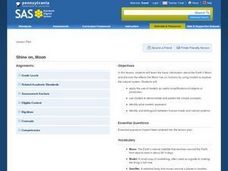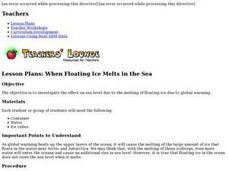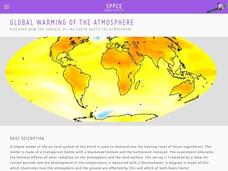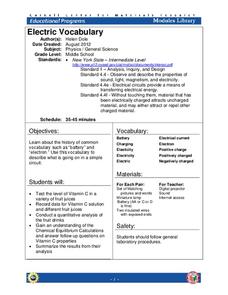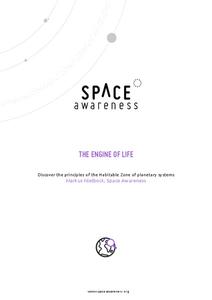Curated OER
Planets in a Bottle
Students experiment with yeast. In this environmental conditions lesson students test the viability of samples of yeast. Students investigate the effects of environmental conditions on the yeast.
Curated OER
Balloon Rockets
Students, after reviewing and analyzing Newton's third law of motion, make balloon rockets and experiment with a variety of models. After the experiment, they chart the results and form conclusions. In addition, they compare/contrast...
Curated OER
Who Is It?/Who Done It?
Students conduct an experiment that allows them to assess individual differences in random DNA sequences and apply those differences when solving a forensic problem. After discussing the polymerase chain reaction and its use to identify...
Michigan Sea Grant
Food Chains and Webs
Starting with a simple food chain, young scientists interpret the difference and interrelatedness between herbivores, carnivores and producers. They answer questions related to cause and effect of food chain disruptions, including the...
Curated OER
Beach Life: Clam Dissection
Young scholars investigate clams. In this clam life lesson, students conduct an experiment where they dissect clams. Young scholars compare anatomies of humans and clams.
Curated OER
What is Plastic?
Students experiment with plastics. In this what is plastic instructional activity, students make a simple polymer and discuss recycling. Students identify various types of plastics.
Curated OER
Glacier Dynamics
Students create flubber glaciers. In this glacier dynamics lesson plan, students experiment factors that may affect glacier speed. Factors include slope, ice temperature, and basal conditions. Students develop hypothesis, conduct...
Curated OER
The Nature and Science of Technology
Fifth graders practice using the scientific method by observing and creating mold. In this bacteria lesson, 5th graders experiment creating their own mold and fungus using petri dishes and oatmeal. Students create an...
Curated OER
Alka-Seltzer Cannons
Fourth graders examine how to conduct a reliable scientific experiment so that the results are valid. They compare and contrast the reaction of Alka-Seltzer tables, one whole and one crushed, and time how long each takes to pop the top...
Curated OER
Shine On, Moon
Students explore space science by conducting an experiment in class. In this Moon instructional activity, students define a list of space science vocabulary and read the book The Moon. Students utilize shoeboxes and string to conduct a...
Curated OER
Weather and Oceans: Uneven Heating of the Earth
Students investigate what causes the heat on Earth. In this Earth heating lesson, students experiment with different heat sources and determine where the Earth gathers the most heat. Students explore vocabulary words...
Curated OER
To Float or Not to Float - A Lesson on Density
Learners observe and experiment with the concept of density. This is done using a simple experiment that helps them to apply scientific principles of observation and proving a hypothesis.
Curated OER
Outgassing
Students demonstrate the concept of outgassing and to explain the origins of the earth's atmosphere. They perform a simple experiment using glass jars, two antacid tablets, and some water. This experiment does a good job in demonstrating...
Curated OER
When Floating Ice Melts in the Sea
With this simple inquiry exercise young scientists observe the effects of melting ice on water level. Set up an easy experiment with floating ice cubes in a dish of water then have your pupils make and record their observations of the...
Curated OER
How Many Drops of Water Can Fit on a Penny?
Using a simple method, learners explore gravity, cohesion, and adhesion. They perform an experiment in which they determine how many drops of water can fit on a penny. Afterwards, they discuss their results.
Curated OER
What Are You Eating?
Discover the calorie content of foods by observing how much heat they produce in water. If you have a calculator-based laboratory (CBL™) insturment for collecting data, then this laboratory worksheet will not need any changes. If...
Center for Learning in Action
Investigating Physical and Chemical Changes
Super scientists visit ten stations to predict, observe, and draw conclusions about the physical and chemical changes that occur when different states of matter—liquid, solid, and gas—are placed under a variety of conditions. To...
Space Awareness
Global Warming of the Atmosphere
Scientists know the amount of carbon dioxide in the atmosphere today is higher than at any point in the last 800,000 years. Scholars learn about the amount of thermic radiation absorbed by air and what happens to the rest of the...
Cornell University
Electric Vocabulary
Practice electric vocabulary using multiple methods. Learners begin by watching a video that explains vocabulary related to electric currents. They match vocabulary cards to practice and then create an electric circuit. Using the...
Polar Trec
Is There Salt in a Glacier?
What can conductivity tell us about a glacier? Groups analyze glacial melt to determine salt content through an analysis of the pH and conductivity measurements of two samples. Groups then determine the source of the salts.
Space Awareness
The Engine of Life
There is a specific zone, or distance from a star, that a planet must be in order to have water in a liquid form. The activity demonstrates how flux density depends on its distance from the source. A photovoltaic cell gets power to...
Curated OER
Sun and Shadows
Why do shadows look different in the summer than in the winter? What causes day and night? How can a sundial be used to tell time? Answer these questions and more through two engaging lessons about light and shadows. Fourth and fifth...
Beyond Benign
Catalysts and Oxygen
Here is an engaging and hands-on lesson plan that allows high school chemists to demonstrate the effects of a catalyst on various chemicals. They garner knowledge of how reactants and products differ from one another, while...
Consumers Energy
Circuits and the Flow of Electricity Lesson Plan
I think I lost an electron. Are you sure? Yes, I'm positive! Starting with a hands-on demonstration and problem solving activity, young scientists define vocabulary related to circuitry and currents. Then they build their own circuits...









